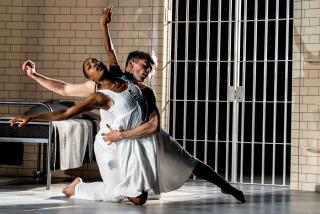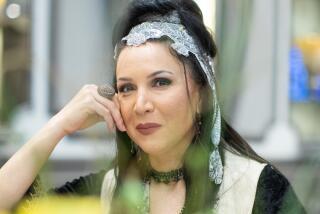Rumi’s passion in half steps
- Share via
In our secular society, it’s hard to imagine the enduring controversy over the relationship between 13th century Islamic poet and mystic Molana (or Mevlana) Jalaleddin Rumi and the much younger holy man and dervish Shams of Tabrizi.
Some sources say these men were lovers and that Shams was murdered by Rumi’s jealous followers; others insist that their relationship was purely spiritual and Shams disappeared on his quest to become what he called “God-intoxicated.”
At its premiere Saturday in UCLA’s Freud Playhouse, the full-evening dance drama “Rumi: Path to Enlightenment” found choreographer Anna Djanbazian and her locally based company mediating between the historical facts and the rich philosophical lore of Rumi’s writings.
Richly costumed and performed with devotion, the result often boasted great ingenuity in making Rumi’s words inspire contemporary dancing -- but just as frequently fell prey to creative confusion and timidity.
In Act 1, the phenomenal Arsen Serobian as Rumi and the intense Ronaldo W. Bowins as Shams hotly eyed each other. But when it came time to dance their passion, they partnered Kristin D’Andrea, a ballerina cast as a symbolic character named Experience.
This same strategy or subterfuge served Frederick Ashton in “Illuminations,” his one-act ballet about the homosexual poet Arthur Rimbaud -- but that was in 1950.
In Act 2, Narineh Ghazarians skillfully danced a character identified as “the Soul of Rumi,” one of several female surrogates presiding over a plotless suite, based on the man’s teachings. Set in motion by sound bites, the divertissement culminated in Aziz Abbatiello’s powerful solo depicting the so-called whirling dervish ceremony, a practice that the grief-stricken Rumi inaugurated after Shams’ death.
Distinguished musicians added their artistry to the “Meditative Prayer” sequence while Edik Balaian’s misty video abstractions periodically established a context for Djanbazian’s choreography.
But by refusing to let Rumi and Shams dance together and banishing them from her final ritual of celebration, Djanbazian allied herself with the followers who tried to drive them apart eight centuries ago. Didn’t she understand that the quote “Bring the secrets in the midst” (used in Act 2) was a demand for absolute openness? As such, it represents a repudiation of all the evasions that left her glossy dance-spectacle safely PG in content but with no real room for Rumi.
More to Read
The biggest entertainment stories
Get our big stories about Hollywood, film, television, music, arts, culture and more right in your inbox as soon as they publish.
You may occasionally receive promotional content from the Los Angeles Times.









